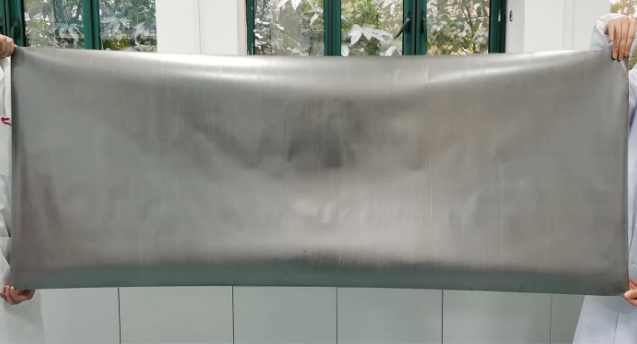Graphene Revolutionary Applications, Commercial Mass Production!
In lithium-ion batteries (LIB), thermal runaway is an extremely serious safety issue. When the rate of heat generation inside the battery exceeds its rate of heat dissipation, local temperatures can rise rapidly, potentially triggering a series of chain reactions. This situation typically arises when the battery operates under conditions such as high power output, overcharging, external heating, or mechanical damage, leading to intensified chemical reactions within the internal materials and further heat generation.
Traditional metal current collectors like aluminum and copper have low thermal conductivity (between 200-400 W/mK), often failing to dissipate heat effectively, especially in high-energy-density batteries, where heat tends to accumulate in localized areas. This localized heat accumulation can lead to catastrophic consequences such as electrolyte decomposition, gas generation, or even battery fires or explosions.
Therefore, managing and controlling heat within the battery is crucial for enhancing safety.
To prevent and control thermal runaway, various methods are often employed in lithium-ion battery design. For instance, effective thermal management systems can monitor and control the battery temperature to prevent localized overheating; battery management systems (BMS) can monitor the battery’s voltage, current, and temperature and take measures when abnormal conditions are detected, such as cutting off the current or cooling; optimizing the structural design of the battery to prevent heat accumulation can reduce the likelihood of thermal runaway. Additionally, using materials with high thermal conductivity (like graphene) to enhance the battery’s heat dissipation capability can also reduce the risk of thermal runaway.
Groundbreaking New Graphene Foil
Recently, Professors He Daping, Mai Liqiang from Wuhan University of Technology, and Yang Jinlong from Shenzhen University collaborated to innovatively research a graphene-based non-metal current collector that can be mass-produced. This breakthrough is expected to significantly enhance the safety and performance of lithium-ion batteries (LIB), addressing a key challenge in energy storage technology. This breakthrough also marks the first successful commercial-scale production of defect-free graphene foil.

“The π-π interlayer interactions and highly ordered stacking structure of graphene enable effective phonon propagation, significantly enhancing its thermal conductivity. The graphene foil studied here has an extremely high thermal conductivity of up to 1400.8 W·m⁻¹·K⁻¹, which is an order of magnitude higher than that of traditional aluminum and copper foils. Graphene current collectors can reduce the risk of thermal runaway by effectively dissipating heat and preventing exothermic reactions that lead to thermal runaway— the dense, well-aligned graphene structure provides a robust barrier against the formation of flammable gases and prevents oxygen from permeating into the battery cell, which is crucial for avoiding catastrophic failures. Importantly, lithium nickel cobalt manganese oxide (LiNi0.8Co0.1Mn0.1O2) || graphite batteries integrated with these temperature-responsive foils demonstrate faster heat dissipation, eliminating localized heat accumulation and avoiding rapid exothermic aluminum thermite and hydrogen evolution reactions, thereby addressing a key factor that contributes to thermal runaway in lithium-ion battery packs.
Additionally, this newly developed process can produce graphene foils in lengths ranging from meters to kilometers, with customizable thickness, resulting in more efficient and safer batteries. To fully demonstrate its potential, the researchers produced a 200-meter-long graphene foil with a thickness of 17 micrometers. This foil maintains high electrical conductivity even after being bent over 100,000 times, making it ideal for flexible electronics and other advanced applications. This innovation could have profound implications for future energy storage, particularly in electric vehicles and renewable energy systems.

Important Applications
According to researchers, this current collector is applicable to various electrochemical applications, such as electrolyzers, fuel cells, and redox flow batteries, showcasing significant application potential.
Pouch Lithium-Ion Batteries: The high thermal conductivity of graphene foil can significantly improve thermal management, allowing batteries to maintain stable operating temperatures under high load and high-temperature conditions, thereby reducing the risk of thermal runaway. This is particularly important for applications like electric vehicles and high-performance portable electronics that require high energy density and safety. Additionally, the lightweight nature of graphene foil can enhance battery energy density, improving device endurance.
Redox Flow Batteries: In large-scale energy storage systems, graphene foil can improve system efficiency and reliability. Its high thermal conductivity helps effectively manage heat within the battery stack, prolonging system lifespan and reducing maintenance costs.
Electrolyzers and Fuel Cells: In electrolyzers and fuel cells, graphene foil can serve as electrode material or current collector, enhancing electrode conductivity and thermal management capabilities. The high surface area and excellent electrochemical stability of graphene provide substantial application potential in these fields, improving energy conversion efficiency and reducing energy consumption.
Electronic Devices and Electric Vehicles: As the demand for high-performance batteries in electric vehicles and portable electronics continues to grow, graphene foil presents vast application prospects in these areas. It can not only enhance battery energy density and charge-discharge rates but also significantly improve safety, reducing the risks of fire or explosion.
Multifunctional Energy Storage Systems: The flexibility and durability of graphene foil make it suitable for energy storage systems that require frequent charge and discharge cycles and endure high mechanical stress. It can maintain stable performance under extreme conditions, making it ideal for aerospace, grid storage, and military equipment that demand high safety and reliability.
In summary, due to its unique physical and chemical properties, graphene foil demonstrates enormous potential in various energy storage and electrochemical applications. Its advantages in enhancing battery safety, energy density, thermal management capabilities, and sustainability position it as one of the key materials for future high-performance batteries and energy storage technologies. With ongoing advancements in production technology, graphene foil is expected to play a critical role in a broader range of industrial applications.

